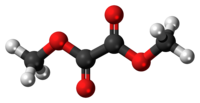Dimethyl oxalate
 |
|
 |
|
| Names | |
|---|---|
|
IUPAC name
Dimethyl oxalate
|
|
| Identifiers | |
|
553-90-2 |
|
| 3D model (Jmol) | Interactive image |
| ChemSpider | 10649 |
| ECHA InfoCard | 100.008.231 |
| PubChem | 11120 |
|
|
|
|
| Properties | |
| C4H6O4 | |
| Molar mass | 118.09 g·mol−1 |
| Appearance | White crystals |
| Melting point | 53 to 55 °C (127 to 131 °F; 326 to 328 K) |
| Boiling point | 166 to 167 °C (331 to 333 °F; 439 to 440 K) |
| -55.7·10−6 cm3/mol | |
| Related compounds | |
|
Related compounds
|
Diphenyl oxalate |
|
Except where otherwise noted, data are given for materials in their standard state (at 25 °C [77 °F], 100 kPa).
|
|
| Infobox references | |
Dimethyl oxalate is a chemical compound from the group of oxalates (specifically, the dimethyl ester of oxalic acid).
Dimethyl oxalate can be obtained by esterification of oxalic acid with methanol using sulfuric acid as a catalyst:
Also the preparation by oxidative carbonylation is possible.
The oxidative carbonylation of methanol forms the C2 block dimethyl oxalate from traditional C1 blocks from synthesis gas, using a Pd2+-catalyzed reaction at relatively mild process conditions and with high yields. The synthesis gas is mostly obtained from coal or biomass. The oxidation proceeds via dinitrogen trioxide, which is formed according to (1) of nitrogen monoxide and oxygen and then reacts according to (2) with methanol forming methyl nitrite:
In the next reaction step of dicarbonylation (3) carbon monoxide reacts with methyl nitrite to dimethyl oxalate in the vapor phase at atmospheric pressure and temperatures at 80-120 °C over a palladium catalyst:
The following sum equation shows that oxygen acts as the actual oxidizing agent dinitrogen trioxide on the reactants and methyl nitrite:
This method is lossless with respect to methyl nitrite, which acts practically as an carrier of oxidation equivalents. However, the water formed must be removed, otherwise the formed dimethyl oxalate can be hydrolyzed.
Interestingly, according to X.-Z. Jiang the course of the reaction depends crucially on the nature of the carrier material on which the palladium catalyst is applied. With 1% Pd/α-Al2O3 dimethyl oxalate is produced selectively in a dicarbonylation reaction, under the same conditions with 2% Pd/C dimethyl carbonate is produced by monocarbonylation:
...
Wikipedia
